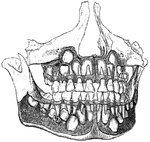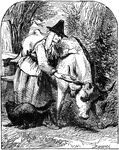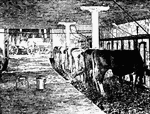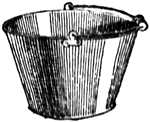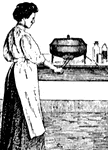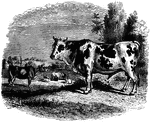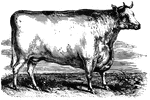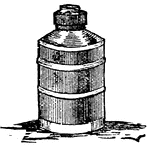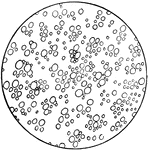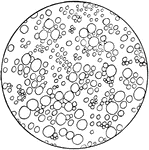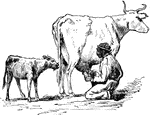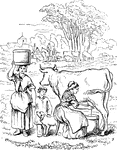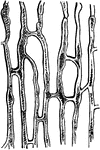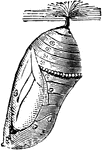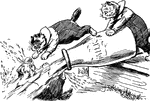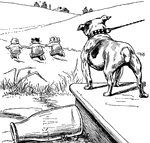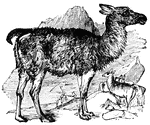
Llama
The llamas of S. America resemble the camel in form and structure. They have, however, no hump, and…
Coconut Palm
Coconut palms are a tropical tree that grow large seeds. From the seed we get milk and oil.

Tom, Tom, The Piper's Son
And as Dolly was milking her cow one day, Tom took out his pipe and began for to play. So Doll and the…

Small-hooded milking pail
A small-top milking pail, with a small hood to keep dirt and other contaminants out.

Large-hooded milking pail
A small-top milking pail, with a large hood to keep dirt and other contaminants out.

Testing Milk
A woman putting milk into a test bottle. The pipette is held at an angle with the test bottle and its…
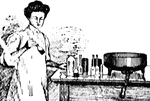
Mixing Milk
A woman mixing milk with acid to test it, using a rotary motion with the bottle not pointed towards…
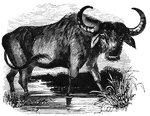
Tame Buffalo
"The tame buffalo is trained to domestic uses, especially for draught, and is commonly employed for…

Short Horn Cattle
"The head is small and finely formed, the eye bright and clear, the horn light in substance and waxy…

Hereford Cattle
"The hereford breed are of a medium or dark red color, with white faces and sometimes white on the throat,…

Jersey Cattle
"The Jersey cattle has a small deer-like head, muzzle fine and dark and encircled by a light color,…

Holstein Cattle
"They are hardly breed and large feeders. Holesteins are remarkable rather for the quantity of their…
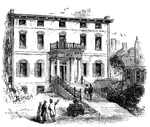
Province House
"The Province House. The Province House, the residence of the colonial governors, is still standing,…
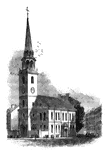
Old South
"The Old South. This venerable and venerated edifice, that stood through all the storms of the Revolution,…
!["A Tooth is one of the hard bodies of the mouth, attached to the skeleton, but not forming part of it and developed from the dermis or true skin. True teeth consist of one, two, or more tissues differing in their chemical composition and in their microscopical appearances. Dentine, which forms the body of the tooth, and 'cement,' which forms its outer crust, are always present, the third tissue, the 'enamel,' when present, being situated between the dentine and cement. The incisors, or cutting teeth, are situated in front. In men there are two of these incisors in each side of each jaw. The permanent incisors, molars, and premolars are preceded by a set of deciduous or milk teeth, which are lost before maturity, and replaced by the permanent ones. The canines come next to the incisors. In man there is one canine tooth in each half-jaw. The premolars (known also as bicuspids and false molars) come next in order to the canines. In man there are two premolars in each half-jaw. The true molars (or multicuspids) are placed most posteriorly. In man there are three molars in each half-jaw, the posterior one being termed the wisdom tooth. The figures [in the illustration] refer to months after birth."—(Charles Leonard-Stuart, 1911)](https://etc.usf.edu/clipart/15200/15256/teeth1_15256_mth.gif)
First Teeth
"A Tooth is one of the hard bodies of the mouth, attached to the skeleton, but not forming part of it…
!["A Tooth is one of the hard bodies of the mouth, attached to the skeleton, but not forming part of it and developed from the dermis or true skin. True teeth consist of one, two, or more tissues differing in their chemical composition and in their microscopical appearances. Dentine, which forms the body of the tooth, and 'cement,' which forms its outer crust, are always present, the third tissue, the 'enamel,' when present, being situated between the dentine and cement. The incisors, or cutting teeth, are situated in front. In men there are two of these incisors in each side of each jaw. The permanent incisors, molars, and premolars are preceded by a set of deciduous or milk teeth, which are lost before maturity, and replaced by the permanent ones. The canines come next to the incisors. In man there is one canine tooth in each half-jaw. The premolars (known also as bicuspids and false molars) come next in order to the canines. In man there are two premolars in each half-jaw. The true molars (or multicuspids) are placed most posteriorly. In man there are three molars in each half-jaw, the posterior one being termed the wisdom tooth. The figures [in the illustration] refer to years after birth."—(Charles Leonard-Stuart, 1911)](https://etc.usf.edu/clipart/15200/15257/teeth2_15257_mth.gif)
Second Teeth
"A Tooth is one of the hard bodies of the mouth, attached to the skeleton, but not forming part of it…
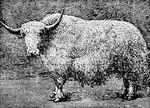
Yak
"Yak is a species of ox from the mountainous regions of Tibet. There are two races: the wild yak, generally…
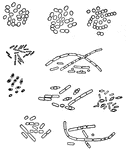
Milk bacteria
"Different Kinds of Milk Bacteria. It is not uncommon for a large number of person to be poisoned from…
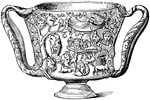
Carchesium
"The carchesium was a beaker, or drinking-cup, which was used by the Greeks in very early times. It…

Danish Milkman
"Denmark is one of the best dairy countries of the world, and I doubt whether there is any other land…

Drinking Tea in Russia
"The Russians drink more tea perhaps than any other people. The tea is served in glass tumblers, with…

Cream Separator
"The cream separator is a machine for separating the cream from the milk. It does the work much better…
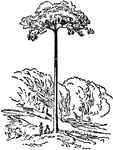
Cow Tree
"A name given to a number of species of tree of different natural orders, the bland milky juice of which…

Cow Tree
"A name given to a number of species of tree of different natural orders, the bland milky juice of which…
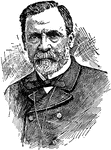
Louis Pasteur
(1822-1895) Famous French chemist and scientist who invented the process of pasteurizing, which prevents…
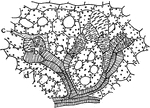
E. Splendens Leaf
"Water-storage tracheids in the leaf of Euphorbia splendens. b, b, water-storage tracheids; d, mesophyll…
